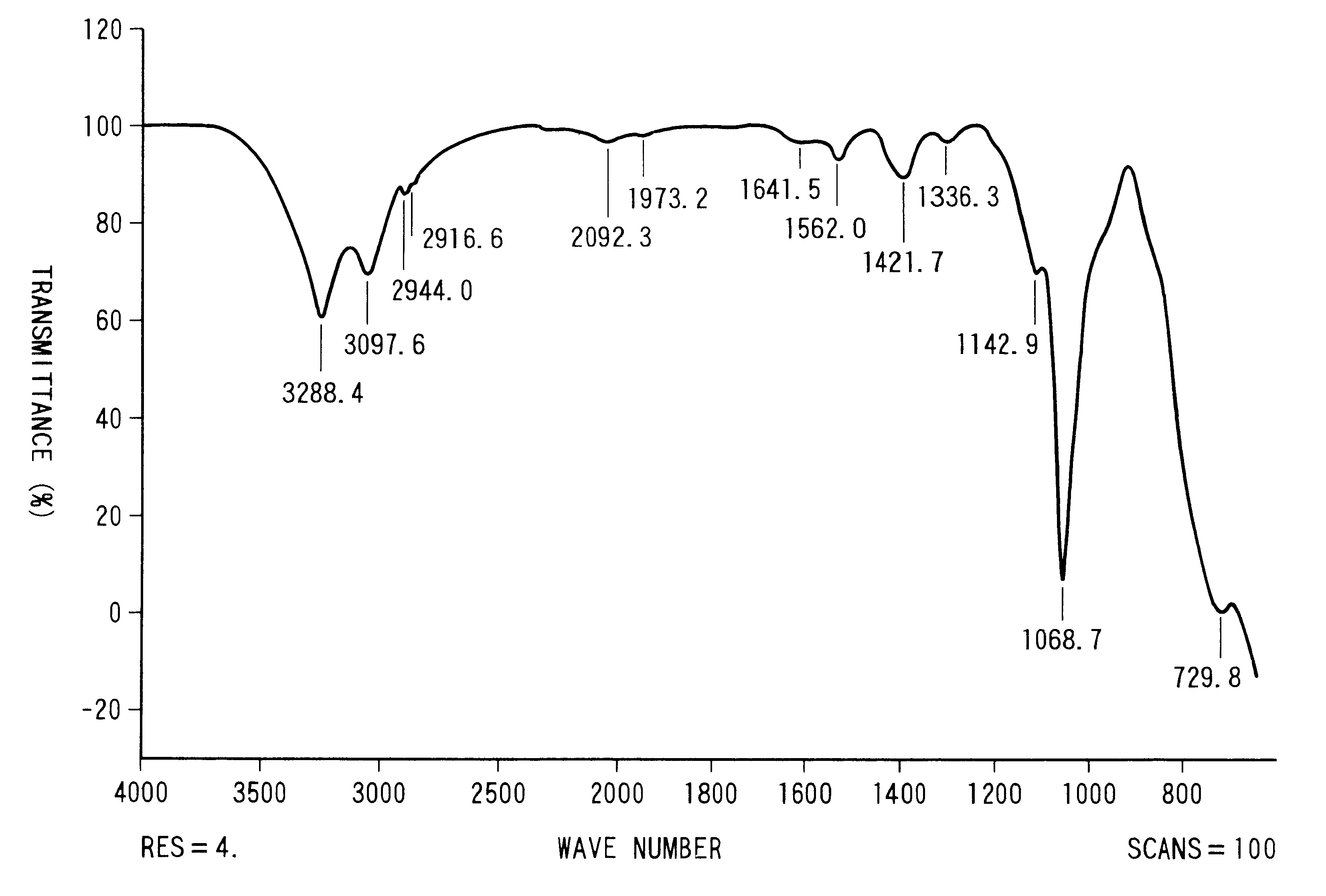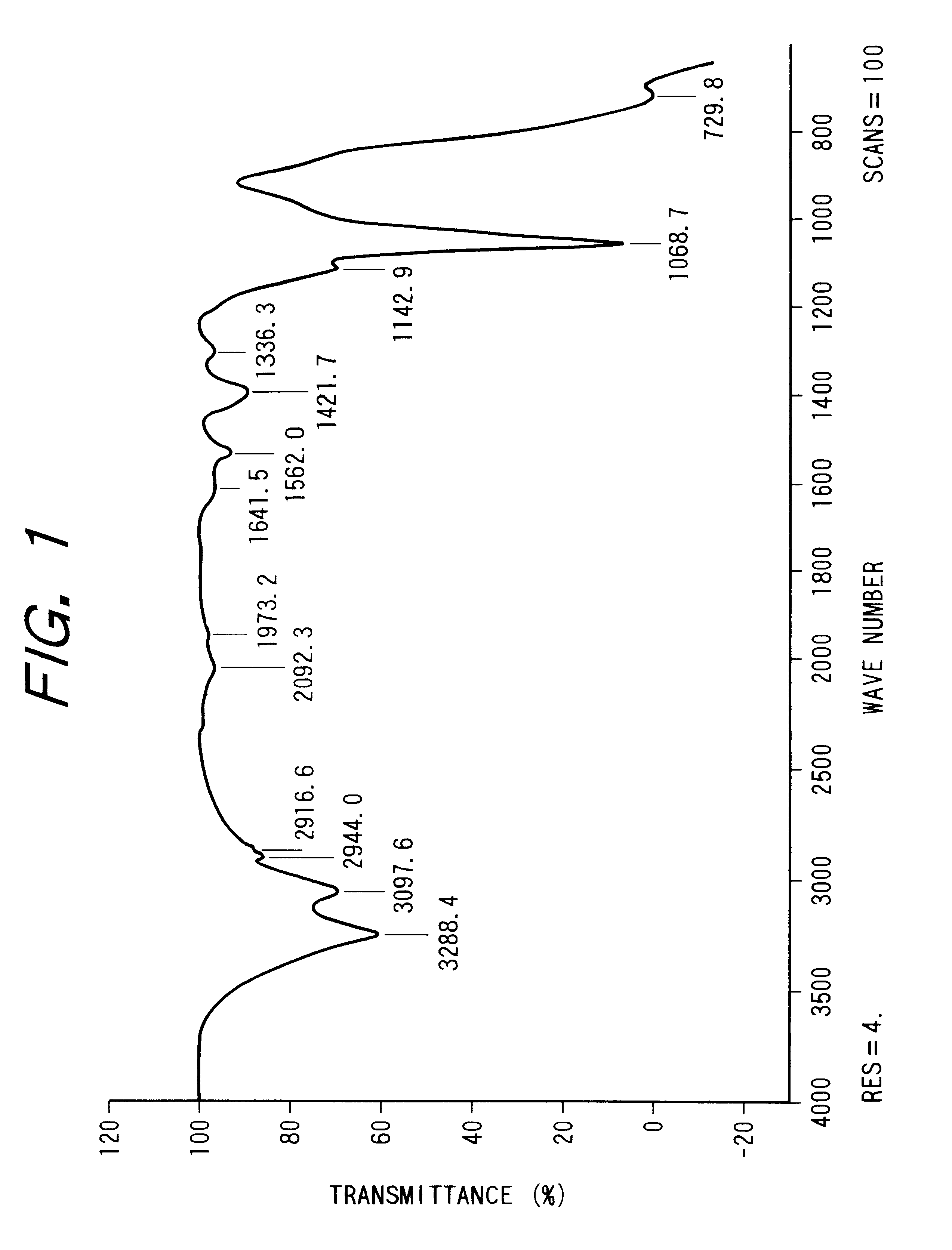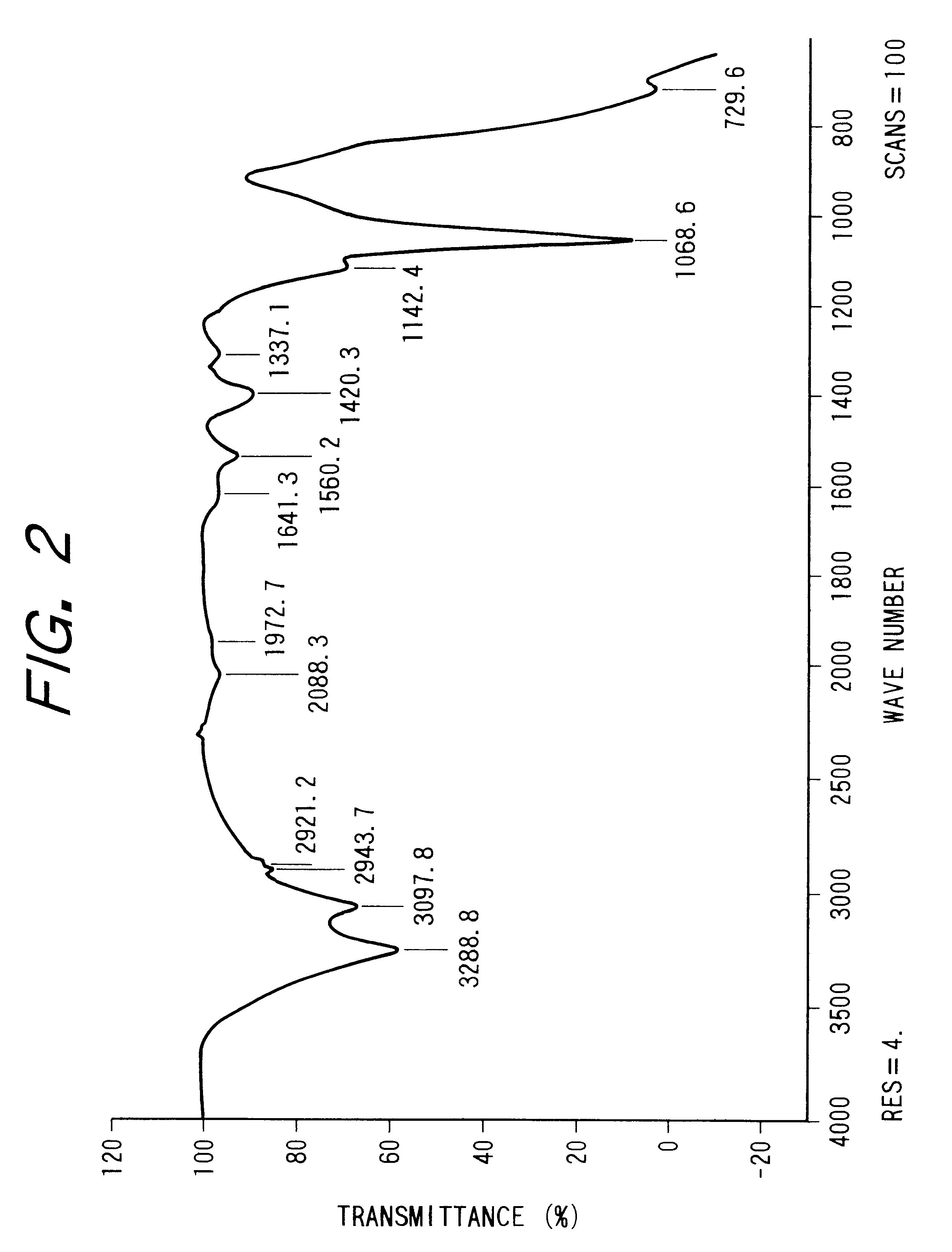This requirement has offered problems to be solved.
However, the ideas described in the above documents only relate to the improvement of properties such as ink absorbency, resolution,
optical density, coloring ability, color reproducibility and transparency, and these documents do not describe anything about problems of beading which tends to markedly occur at printed areas on printing media when using inks comprising a surfactant, and means for solving such problems.
It is said that beading readily occurs in particular on media low in ink absorbency or slow in fixing speed of a dye in an ink.
There are the following problems in the conventional measures for the beading.
However, when printing is conducted with these inks on a porous ink-receiving layer comprising, as an principal component, a
alumina or silica material, there arises a problem that the absorption of the inks becomes poor, or beading occurs.
However, the occurrence of beading also depends upon the fixing quantity and speed of a dye in an ink, so that the occurrence of beading cannot be prevented only by the increase of the ink-absorbing rate.
Further, these documents do not describe anything about the measures for beading occurring upon the use of inks containing a surfactant.
However, the beading phenomenon is also caused by aggregation of a dye in an ink, so that the occurrence of beading cannot be prevented only by the improvement of the ink absorbency.
Further, these documents do not describe anything about the measures for beading occurring upon the use of inks containing a surfactant.
However, since the quantity of the dye to be adsorbed on the ink-receiving layer also depends upon the specific surface area and
coating weight of a material from which the receiving layer is formed, and low ink absorption also forms the main cause of beading, the occurrence of beading cannot be prevented only by the use of a material the dye-adsorbing capacity of which has been regulated.
Further, these documents do not describe anything about the measures for beading occurring upon the use of inks containing a surfactant.
However, the method of adjusting the wettability of the surface involves a problem that since its ink-absorbing rate becomes low, the resulting printing medium tends to cause beading when the quantity of an ink ejected on the printing medium increases.
Further, these documents do not describe anything about the measures for beading occurring upon the use of inks containing a surfactant.
If the ink-absorbing time exceeds 400 milliseconds, the ink droplets become greater beads on the surface of the ink-receiving layer before they are absorbed, whereby the dye aggregates, resulting in the occurrence of beading,
feathering and / or bleeding.
However, since the concentration of the dye is thin, the adsorption rate is extremely low compared with the dropping rate.
Therefore, the adsorption quantity cannot be exactly determined, and besides the
alumina sol colored with the dye cannot be separated from a supernatant because the alumina
sol has good dispersion property in water, so that the coloring state of the supernatant cannot be observed.
Accordingly, such a method is not a suitable measuring method.
If the dye-adsorbing capacity is lower than 900 mg / m.sup.2, the dye in the ink applied is not fully adsorbed, so that
feathering may occur, the dye aggregates in the interior of the ink-receiving layer, thereby lowering the
optical density of an image formed when observing by transmission or from the side of the base material, or the water fastness of the image may be deteriorated in some cases.
If the dye-adsorbing capacity exceeds 2,000 mg / m2, the dye is fixed before the ink is fully spread, so that the
diameter of printed dots becomes too small, and blank areas are hence caused, resulting in an unnatural image like a stipple.
If the index of dye-adsorbing rate is smaller than 0.0, the dye in the ink applied aggregates on the ink-receiving layer or in the interior thereof, so that the correspondence of the quantity of the ink applied to the optical density becomes poor, and
gradation is hence deteriorated.
If the concentration of the surfactant is lower than 1% by weight, the surfactant-adsorbing rate becomes low, and the quantity of the clear ink to be applied increases to cause ink
feathering.
Therefore, the adsorption quantity cannot be measured with precision.
If the concentration of the surfactant is higher than 1% by weight, the surfactant itself becomes easy to aggregate, so that the measurement cannot be conducted with precision.
If the surfactant-adsorbing capacity is lower than the
lower limit of the above range, a printing medium having such an ink-receiving layer tends to cause beading when printing is conducted with an ink containing the surfactant in a greater amount.
If the capacity exceeds the upper limit of the above range on the other hand, the adsorption and fixing of dyes to such an ink-receiving layer may be inhibited, and so the water fastness of the resulting image may be deteriorated in some cases.
The dye is added into such aggregate, thereby causing beading.
As a result, the
micelle structure is broken, and the dye remaining in the
solvent aggregates by itself to cause beading.
If the interplanar spacing is shorter than the
lower limit of the above range, the catalytic active sites of such an
alumina hydrate increases, so that an image printed on the printing medium becomes easy to cause discoloration with time.
Further, the hydrophobicity on the surface of the
alumina hydrate becomes strong, so that wettability by inks becomes insufficient.
Therefore, the resulting printing medium tends to cause cissing, or on the other hand, to cause feathering and beading when a hydrophilic dye is used.
In addition, the
bonding strength to the binder resin becomes weak, so that the resulting printing medium tends to cause
cracking and dusting.
If the interplanar spacing exceeds the upper limit of the above range, the amount of water contained between
layers of such an
alumina hydrate increases, and the amount of water evaporated upon the application of a
coating formulation containing the alumina
hydrate hence increases, so that the resulting printing medium tends to cause
curling and / or
cracking.
In addition, such an alumina
hydrate has high water absorption, so that the resulting printing medium may cause
curling and
cracking, or undergo a change of ink absorption according to environmental conditions.
Further, since the surface of the alumina hydrate becomes hydrophilic, the printing medium tends to cause feathering and beading when a hydrophobic dye is used, and the water fastness of an image printed on the medium is deteriorated.
Besides, the
bonding strength of such an alumina hydrate to the binder becomes low, resulting in a printing medium that is readily subject to cracking.
If the size exceeds the upper limit of the above range,
haze occurs on the printing medium, and so its transparency is deteriorated, and the optical density of an image printed on the medium is further lowered.
If the valence of
titanium in
titanium dioxide becomes lower than +4, the
titanium dioxide comes to serve as a catalyst, and the binder is hence deteriorated, so that the resulting printing medium is readily subject to cracking and dusting, and an image printed on the medium is discolored.
On the other hand, any average
aspect ratio higher than the upper limit of the above range makes it difficult to produce the alumina hydrate with its particle size even.
If the average particle
diameter or average particle length is greater than the upper limit of the above range, the resulting printing medium cannot sufficiently adsorb a dye in an ink applied thereto.
If the BET specific surface area is smaller than the
lower limit of the above range, the resulting ink-receiving layer becomes opaque white, or its adsorption sites to a dye in an ink become insufficient, so that the water fastness of an image printed thereon is lowered.
If the BET specific surface area is greater than the upper limit of the above range, the resulting ink-receiving layer becomes easy to cause cracking.
If the average pore
radius is larger than the upper limit of the above range, the resulting printing medium is deteriorated in the adsorption and fixing of a dye in an ink, and so feathering or bleeding tends to occur on an image formed.
If the average pore
radius is smaller than the lower limit of the above range, the resulting printing medium is deteriorated in ink absorbency, and so beading tends to occur.
If the half breadth is wider than the upper limit of the above range, the resulting printing medium is deteriorated in the absorption of a dye in an ink.
If the half breadth is narrower than the lower limit of the above range, the resulting printing medium is deteriorated in the absorption of a
solvent in an ink.
If the pore volume of the ink receiving layer is greater than the upper limit of the above range, cracking and dusting tends to occur on the ink-receiving layer.
If the pore volume is smaller than the lower limit of the above range, the resulting printing medium is deteriorated in ink absorption.
If the pore volume is smaller than this limit, inks tend to run out of the ink-receiving layer when multi-
color printing is conducted, and so bleeding occurs on an image formed.
If the pore
radius corresponding to the former peak is larger than the above limit, the resulting printing medium is deteriorated in the adsorption and fixing of the dye in the ink, and so bleeding or feathering and beading occur on an image formed.
If the pore radius corresponding to the latter peak is smaller than the lower limit of the above range, the resulting printing medium is deteriorated in the absorption of the
solvent component in the ink, so that the ink is not well dried, and the surface of the ink-receiving layer remains wet even when the medium is discharged out of a printer after printing.
If the pore radius corresponding to the latter peak is greater than the upper limit of the above range, the resulting ink-receiving layer tends to crack.
If the pore volume of the ink-receiving layer is greater than the upper limit of the above range, cracking and dusting tend to occur on the ink-receiving layer.
If the pore volume is smaller than the lower limit of the above range, the resulting printing medium is deteriorated in ink absorption.
If the pore volume is smaller than this limit, inks tend to run out of the ink-receiving layer, in particular, when multi-
color printing is conducted, and so bleeding tends to occur on an image formed.
If the amount of the binder is less than the lower limit of the above range, the
mechanical strength of the resulting ink-receiving layer is insufficient, which forms the cause of cracking and dusting.
If the amount is greater than the upper limit of the above range, the pore volume of the resulting ink-receiving layer is reduced, resulting in a printing medium poor in ink absorbency.
Therefore, such a great or small dot
diameter ratio results in a failure to prevent the occurrence of beading.
If the heat-treating temperature or the heat-treating time is lower or shorter than the lower limit of the above range, the dye-adsorbing capacity of the resulting ink-receiving layer becomes smaller than the lower limit of the above range, the resulting printing medium undergoes
curling due to environmental changes or by aging, or its ink-receiving layer becomes readily subject to cracking.
If the amount is less than the lower limit of the above range, on the other hand, it is impossible to delicately change the surface profile of the porous surface of the resulting ink-receiving layer, and so beading tends to occur on such an ink-receiving layer.
If the amount is less than the lower limit of the above range on the other hand, it is impossible to delicately change the surface profile of the porous surface of the resulting ink-receiving layer, and so beading tends to occur on such an ink-receiving layer.
If the temperature is lower than the lower limit of the above range, the dispersion treatment becomes insufficient, or aggregation occurs.
If the coat weight exceeds the upper limit of the above range, cracking tends to occur, and the ink-absorbing rate of the resulting printing media is lowered.
If the
coating weight is smaller than the lower limit of the above range, the ink absorption of the resulting printing medium becomes insufficient, and its index of dye-adsorbing rate is lowered.
1. The present invention relates to a printing medium in which the ink-absorbing rate, dye-adsorbing capacity and index of dye-adsorbing rate of an ink-receiving layer to an ink containing 0.1% by weight of a surfactant are adjusted within the specified ranges. The printing medium has an effect of preventing the occurrence of beading when conducting printing with inks containing a surfactant. By adjusting the surfactant adsorption of the ink-receiving layer within the specified range, the printing medium has an additional effect of preventing the occurrence of beading even when conducting printing with inks containing 1 to 10% by weight of a surfactant. The prior art does not disclose anything about the method for preventing the occurrence of beading when conducting printing with an ink containing the surfactant or an ink containing a high portion of the surfactant.
2. The prior art discloses a printing medium in which the porous structure, such as pore radius distribution and pore volume, of an ink-receiving layer are adjusted to increase its ink-absorbing rate and ink absorption quantity. The prior art also discloses a printing medium in which a resin material having high solvent absorbency is used in an ink-receiving layer, or a surfactant is added to an ink-receiving layer, thereby enhancing its ink-absorbing rate and ink absorption quantity. These are based on an idea that the ink-absorbing rate of the ink-receiving layer is enhanced, thereby preventing the occurrence of beading due to the growth of ink droplets on the surface of the ink-receiving layer. However, they do not describe anything about the fixing of a dye in the ink absorbed in the interior of the ink-receiving layer and prevention of its aggregation. Further, these documents do not describe the measures for the beading caused by inks containing a surfactant.
However, although the dye-absorbing capacity and index of dye-adsorbing rate strongly depend on not only the physical properties of materials used, such as pigments and resins, but also the dry solids content, thickness and specific surface area of the ink-receiving layer formed, the prior art does not describe this fact.
However, the prior art does not describe anything about the measures for beading caused by inks containing a surfactant.
 Login to View More
Login to View More 


